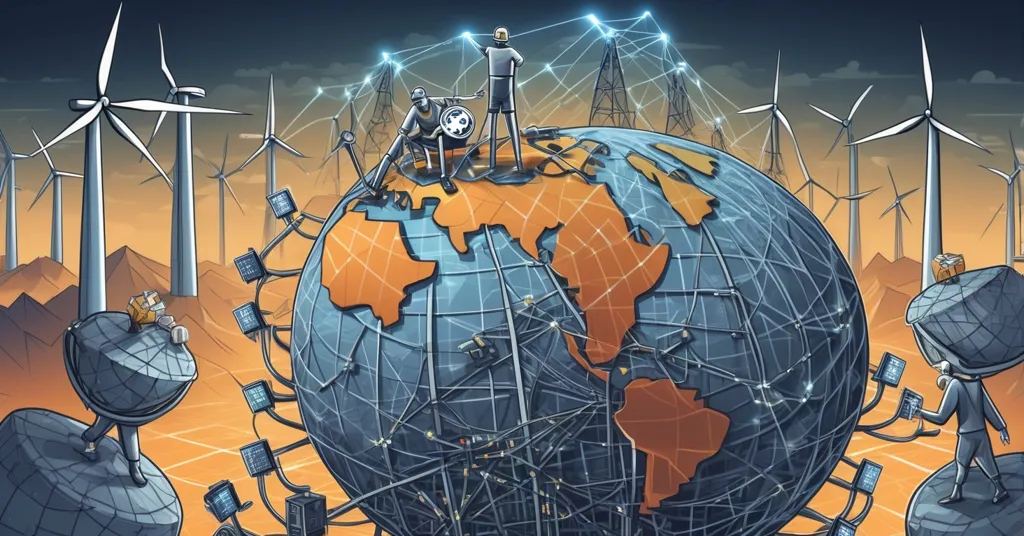Bitcoin Miners Shift to AI Amid Challenges: Microsoft’s Impact and Global Energy Hunt

Bitcoin Miners’ AI Pivot: Navigating the Downward Spiral
Bitcoin miners are pivoting to AI data centers in hopes of finding a new revenue stream, yet the move has not been the financial lifeline they hoped for. As share prices decline and operational costs remain high, the industry’s foray into AI is fraught with challenges.
- Microsoft’s data center lease cancellations cause share price drops.
- Increased revenue does not translate to profitability for miners.
- Pakistan and Africa emerge as hotspots for miners seeking cheap energy.
- The sustainability and societal value of Bitcoin mining face scrutiny.
The Microsoft Effect
On March 26, the crypto mining sector felt the sting as shares of prominent Bitcoin miners plummeted. This followed Microsoft’s decision to cancel data center leases across the United States and Europe, a move influenced by its 49% stake in OpenAI and a strategic retreat from commitments with AI hyperscaler CoreWeave due to unmet timelines. Core Scientific, entangled in a multi-billion-dollar deal with CoreWeave, saw its share price drop by 11%. Miners like Hive Digital, Hut 8, and Iris Energy also experienced declines, signaling the ripple effect of Microsoft’s decision throughout the sector.
The Harsh Economics of Bitcoin Mining
The financial landscape for Bitcoin mining remains brutal. The cost to mine a single Bitcoin token averages around $85,200, just shy of the current BTC value. This high cost, combined with Bitcoin’s constrained bandwidth, which limits transaction fee revenue to a mere low-single-digit percentage of miners’ income, squeezes profit margins. The Bitcoin mempool, which recently saw nearly 50,000 backlogged transactions, has driven transaction costs over $2.00, yet this still barely dents miners’ revenue needs.
Financial Insights: A Mixed Bag
Despite the challenges, some miners report increased revenue. Canaan Inc., for instance, saw a gross loss despite higher revenue, while Bitfarms managed a net income thanks to a tax recovery. BitFuFu, an affiliate of Bitmain, celebrated significant revenue growth. However, these financial wins are often overshadowed by rising operational costs, leaving many miners struggling to break even.
Global Energy Hunt
In pursuit of cheaper energy, miners are setting their sights on regions like Pakistan and Africa. Pakistan, grappling with a sluggish economy that generates surplus electrical power, is contemplating special electricity tariffs to attract crypto and blockchain operations. Meanwhile, in Zambia, Gridless leverages a remote hydroelectric plant for its mining activities. As Gridless co-founder Philip Walton noted:
“We recognized that in order to get better mining economics we needed to partner with the power company here and give them a revenue share.”
Such partnerships are becoming crucial as the hydroelectric plant eyes a connection to the national grid, which could raise costs.
Security and Energy Concerns in Russia
Russia faces its own set of challenges with Bitcoin mining, particularly around energy consumption and security. The country implemented winter mining bans in Siberia, reducing energy consumption by 300MW. Additionally, Russia has raised alarms about hackers exploiting IoT devices for mining, urging consumers to bolster their device security. This underscores the broader security implications tied to the industry’s energy demands.
The U.S. Response: Challenging Chinese Dominance
In the U.S., Auradine, Inc. has made strides with the introduction of the Teraflux AH3880, a domestically engineered hydro-cooled Bitcoin miner. This move comes amidst a push for domestic production, supported by companies like MARA. It’s a bold challenge to China’s stronghold on mining hardware, though the effectiveness of this strategy remains to be seen.
The AI Pivot: A Rocky Road
The pivot to AI data centers was seen as a potential lifeline for miners struggling with Bitcoin’s economics. However, this shift has proven challenging. As one critic sharply puts it:
“BTC’s future relies on hopium, primitive nationalism, and the endless pursuit of greater fools to take these utility-free digital casino chips off their hands at a greater price than they were purchased.”
This harsh assessment highlights the speculative nature of Bitcoin and the miners’ reliance on market trends and cheap energy.
A Glimmer of Hope: Sustainability and Innovation
Despite the industry’s woes, there are signs of optimism. A significant 53% of mining energy now comes from renewable sources, offering hope for a more sustainable future. The potential for growth in the AI sector remains, with predictions suggesting a $37 billion increase in market capitalization for Bitcoin mining stocks if they invest heavily in AI. Yet, the road ahead is uncertain. Miners must continue to innovate and adapt to navigate the post-halving landscape, where efficiency improvements and sustainable solutions will be key to survival.
Key Takeaways and Questions
- What caused the decline in share prices of Bitcoin miners?
The decline was triggered by Microsoft’s cancellation of data center leases, affecting miners who had pivoted to AI data centers.
- How are Bitcoin mining economics affecting miners’ profitability?
The high cost of mining, around $85,200 per token, coupled with the low revenue from transaction fees due to BTC’s constrained bandwidth, is squeezing miners’ profit margins.
- What strategies are countries like Pakistan and regions in Africa adopting to attract Bitcoin miners?
Pakistan is considering special electricity tariffs to lure miners, while African regions like Zambia are leveraging remote hydroelectric plants, though facing challenges with grid connectivity.
- What security concerns are associated with Bitcoin mining in Russia?
Russia is concerned about the strain mining puts on local grids and has warned about hackers using IoT devices to mine crypto, urging consumers to update their device security.
- How is the U.S. positioning itself in the Bitcoin mining hardware market?
The U.S. is attempting to compete with Chinese dominance in mining hardware through companies like Auradine, which introduced the Teraflux AH3880, amidst political support for domestic production.



